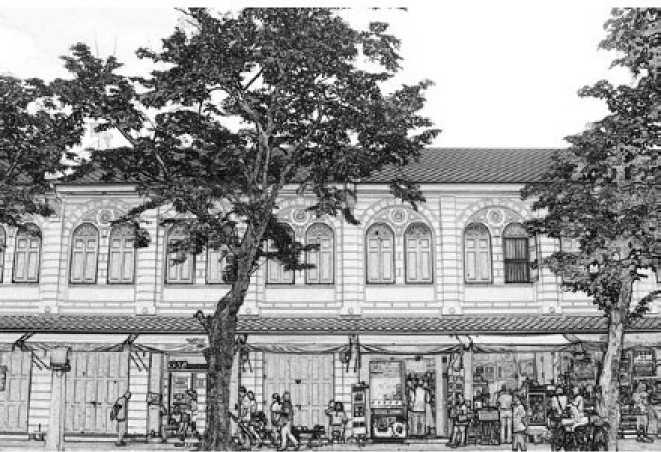Along the Riverbank
Along the Rattanakosin Island riverfront we find two universities, a couple of busy river piers, two of the city’s leading temples, and some classic late nineteenth century shophouses. Duration: 1 hour
From Sanam Luang, facing the river, look for the narrow lane named Phra Chan Road, which runs between Thammasat University and Wat Mahathat. Thammasat was founded in 1932 to service the new political system that was transforming the country, and at its core are four old military buildings that once formed part of the Front Palace Outer Court. Linked by a single roof the buildings are topped by an unmistakable tower, the symbol of the university, taking its design from ancient Siamese forms that are to be found in the north of the country. Underneath the tower is a clock, and the room directly beneath the clock was the office of the founder, Pridi Banomyong, who was one of the leaders of the People’s Party that overthrew the absolute monarchy. At the entrance to Phra Chan Road is a massive gate, and running along the entire northern side of the road is a white crenelated wall that looks as if it belongs to the Grand Palace but which had originally surrounded the palace of Prince Prachak Silpakorn, a son of Rama IV, who founded Udon Thani in the northeast of Siam at a time when French colonialists were forcing the Siamese to concede large areas of Laos that had been under the rule of Bangkok. The road itselfis one of the city’s oldest thoroughfares, with little shops on the south side selling temple artefacts, Buddhist amulets and civil service uniforms. On a Sunday morning the street, and indeed the whole of Phra Chan Road, comes alive with vendors selling amulets, and there is no shortage of buyers: everyone from monks to merchants to tourists shops here.
The reason for all this amulet activity is Wat Mahathat, which predates the founding of Bangkok itself, and houses relics of the Buddha, the name translating as “Temple of the Great Relic”. Home to Maha Chulalongkorn Ratchawitthyalai University, the country’s oldest higher education institute for monks, it is the residence of the Supreme Patriarch of the Mahanikai sect of Buddhism and also houses the Vipassana meditation school, which is free for everyone, overseas visitors included. Prince Surasinghanart, whose statue stands at the main gate facing Sanam Luang and who was a younger brother of Rama I, renovated Wat Mahathat around 1783. Further renovation took place when Prince Mongkut studied here as a young monk, before he became Rama IV. The temple compound is a spacious one, although jammed with school buildings, the monks’ quarters and offices, along with what is believed to be the largest ordination hall in Bangkok, and an almost equally large assembly hall. The small Wiharn Noi is the prayer hall used by Prince Mongkut, while the red building known as Akarn Watthu was Bangkok’s first library. The most important structure is the mondop, or scripture hall, inside of which is the chedi in which are placed the Buddha relics. Covered in gold leaf, the chedi is a classic example of the early Rattanakosin style, while the main Buddha image, Phra Nak, is made of bronze and sculpted in the Sukhothai style. Somehow, in this crowded temple compound, where there is even a herbal medicine market, there is room for a garden with tall palm trees, and despite the crowds and traffic outside the atmosphere inside is one of peace. It must be the meditation.
At the end of Phra Chan Road is a pier, usually crowded as it is used by students and staff of the immense sprawl of Siriraj Medical School on the west bank, in addition to the Thammasat and Silpakorn universities on the east bank. Pass along Maharat Road, with the overhanging eaves of Wat Mahathat on one side and some dilapidated shophouses on the river side, followed by the geometric cream-coloured buildings of the Royal Thai Army, and there on the corner, looking diagonally across to the Grand Palace, are the grandest shophouses in Bangkok. Built in the late nineteenth century, they show just how elegant the commercial buildings of that era could be. The Royal Crown Property Bureau owns the building, which has recently been restored. There are thirty-three units encased in gleaming white stucco, with pediments and pillars and green painted shutters and window frames. The splendid premises of the Siam Commercial Bank on the corner retain the style of an old counting house. This area outside the palace walls was assigned for bathing the royal elephants each day. A pier was built here for the mahouts and the area became known as Tha Chang Wang Luang, or “Elephant Pier of the Grand Palace”.

Behind the Tha Chang shophouses, almost invisible and accessed by a small gate, is the campus of Silpakorn University. The compound is tiny, crammed with an odd mixture of historic architecture, nondescript buildings from the 1950s and 60s, scattered sculptures, and overhung by ancient trees and thronged with students. Silpakorn was the first university of art in Thailand, and the cradle of modern Thai art. Tha Phra Palace, the architectural centrepiece of the campus, is one of the oldest buildings on Rattanakosin Island. It was built for Prince Kasattranuchit, a nephew of Rama I, and the prince lived here until his death during the reign of Rama II. The king presented the palace to his son, Prince Chesdabodin, who was head of several government units such as the Harbour Department, the Police and the Royal Treasury. Eventually the prince asended the throne as Rama iii, and handed over the palace to three of his sons in succession. One of them was Prince Jumsai, who headed the royal craft departments, including the Stonework Department and the Department of Ten Fine Arts Units. Interestingly, then, Tha Phra Palace’s connection with the arts dates back to the first half of the nineteenth century.
Rama V handed the palace on to Prince Naris, one of his brothers. Prince Naris, one of Siam’s great patrons of the arts, held positions including Minister of Public Works, Minister of the Treasury, and Minister of the Royal Household, serving through five reigns and passing away in 1948. He was the last prince to occupy this palace, eventually moving away from the congestion of Rattanakosin for health reasons, having built Plainoen Palace in the then pastoral surroundings of Klong Toei. After his death the prince’s heirs sold Tha Phra Palace to the government, and it was assimilated into the newly founded Silpakorn University.
The palace adjoins the gracious old mansion that houses the Fine Arts Department, and here for many years was a school that taught painting and sculpture to civil servants and other students, who were
Accepted without fees. In the reign of Rama VI an Italian sculptor named Corrado Feroci arrived in Bangkok to teach at the Royal Academy’s Fine Arts section. He was later made principal of the artisans’ section of the Fine Arts School. During World War II Feroci took Thai citizenship, adapting the Thai name Silpa Bhirasri. When the school was upgraded to university status in 1943 and named Silpakorn, he became Dean of the Faculty of Sculpture. Professor Silpa Bhirasri, whose works can be seen throughout Bangkok and elsewhere in Thailand, did more than anyone to introduce modern European ideas and techniques to Thai artists, and today his personality still makes its presence felt throughout the university campus.
Walk through the campus at almost any time of the day, it seems, and there are crowds of students meeting before class, sitting under the trees sketching, eating outside the cafeteria, or just standing and chatting. Tha Phra Palace is a neo-classical style building, very European, its exterior a faded yellow and white. Quite how European it was when first built is unclear. The interior follows a traditional palace plan for its time, but Prince Naris made many Western style changes during the reign of Rama V. During this time he erected three other European buildings in the compound, and used the opportunity to place fluted columns inside the main hall, add shutters and awnings to the windows, and replace the main staircase with a fashionable spiral one that the prince named the “One Slip and You’re Dead Staircase”.
The Throne Hall, by contrast, is a traditional Thai building with a red-tiled roof. Prince Jumsai had used the Throne Hall as a school for his artisans, and it was a workshop for the carpenters, the wood-carvers, the mosaic artists and the cloth painters who came under the department. A pleasant place for the students to gather is the Music Pavilion, a timber structure built in the time of Rama V. Painted a pale green, the pavilion has lovely fretwork and Western-style wooden railings. Curiously, one side is a solid wall, but the pavilion was originally on the boundary of the outer and inner courtyards, and a stretch of the old wall can be seen up against the Throne Hall. Further into the campus, opposite the Faculty of Painting, Sculpture and Prints, stands a statue of Professor Silpa, and there is a small museum built around what was his study.
Exit through the main gate and into Na Phra Lan Road, and there is another row of shophouses from the time of Rama V, different in style to their Tha Chang neighbours but equally as graceful. Recently renovated by the Crown Property Bureau, a restoration project that received an honourable mention in the unesco awards, the building was not initially designed as shophouses but was used for housing foreign visitors to the Grand Palace. On the corner of Na Phrathat Road is the Fine Arts Department, distinguished by the frieze that runs the length of the building under the eaves. Next to this is a building that is a vivid ochre in colour, designed in a Khmer style. It looks as if it should be important, yet there is a discomforting blankness about it, not helped by the parked tour buses that obscure the frontage, belching out diesel fumes as they idle over to keep their air conditioners working. This is the Thawornwatthu Building. Crown Prince Vajirunhis was the first son of Rama V and his highest consort, Queen Savang Vadhana. The king had decided to abolish the position of deputy king and to instead create the position of crown prince, a role that the talented young man seemed destined for, but Vajirunhis died of typhoid at age 16. The king’s second son, Vajiravudh, became crown prince and eventually ascended the throne as Rama VI. Rama V decided it would be inappropriate to continue with the old tradition of constructing a large funeral building for a single purpose, and instead ordered Prince Naris to build Thawornwatthu, which after the royal funeral was to be given over for the education of monks and novices. In 1916, under the decree of Rama VI, the Vajirunhis National Library, an amalgamation of three royal libraries, was housed here and made accessible to the general public. Over the years various collections were added to the library until it outgrew its premises. A new National Library building was opened in Samsen Road in 1966, and today Thawornwatthu is home to the Naradhip Centre, a library and research centre for the social sciences.
Maharat Road passes between the palace and the river, a long walk with only the high white crenellated wall on one side and a screen of trees with occasional glimpses of the river on the other. Opposite the fortress-like entrance gate of the palace is the Ratchaworadit Royal Pier and Ratchakit Winitchai Throne Pavilion, built in the reign of Rama iv and used exclusively for royal ceremonies. Next to this, in the curious way in which prosaic buildings are so often found rubbing shoulders with the splendid, are the buildings of the Naval Welfare Department, the Navy Wives Association, the Public Warehouse Organisation, and offices belonging to the Department of Internal Trade. Opposite the southern corner of the Grand Palace wall there used to be a stone-crushing plant, a rong mo hin, and the name is remembered in the name of the Tha Rong Mo pier, a concrete structure encased by rickety timber buildings, from which ferries ply across to the Temple of the Dawn. Next to the pier is another handsome parade of Rama V era shophouses, still awaiting the restoration paint but solid enough and with green shutters and fanlights over the windows. This is Tha Tian, the building housing a wet market that is well-known for its salted fish, the name adopted after a fire during Rama iv’s reign that completely destroyed the previous buildings, which had been used for accommodating foreign visitors; tian meaning “flat” or “clear”.
One of the most heartening conservation developments in Bangkok recently has been the opening of boutique hotels in a number of different locations, reviving ancient buildings that were previously looking very sad. Tucked into the lanes immediately behind Tha Tian are a couple of outstanding examples. A four-storey warehouse has been turned into a twelve-room hotel named Aurum The River Place, while an eighty-year-old Sino-Portuguese style wooden house, painted beige, yellow and green, and standing on land owned by Wat Pho, has been transformed into a six-room hotel named Arun Residence. Both of these offer the prospect of waking up to the sight of the Temple of the Dawn, directly across the river.
A few metres further down Maharat Road is an even more surprising development. Chakrabongse House, a palatial residence built in 1908 for Prince Chakrabongse and, except for its three-storey timber tower, formerly invisible behind a high wall, has had three villas in its gardens converted into luxury suites for guests, who also have their own swimming pool. Branded Chakrabongse Villas, it would be difficult to image a more exotic place in which to stay. The prince had been born in 1883, the fortieth child of Rama V, and had been invited by Tsar Nicolas ii, a close friend of the king, to study in Russia. He was later appointed a colonel in the Hussar Regiment, and returned to Siam with a Russian wife. In Bangkok he became Chief of the General Staff of the Royal Siamese Army, and Minister of War, and today is remembered as the Father of the Royal Thai Air Force. The prince’s granddaughter Narisa Chakrabongse today owns the house.
The enormous temple that takes up so much space at this southern end of Inner Rattanakosin Island is Wat Pho, aka Wat Phra Chetun, aka the Temple of the Reclining Buddha. Covering twenty acres, the temple compound is actually bisected by Chetupon Road, the more interesting side lying to the north while the southern side is mostly the monastery and school buildings. There has been a temple standing on this site since long before the days of Bangkok, 200 years before, according to some accounts. Named Wat Phodharam (which is why the Thais use the name “Pho”, not the formal name of “Chetupon”), it was a centre for studying traditional medicine and massage, and stone figures and carvings were created showing massage and yoga positions. The temple is considered the first public university in Thailand, teaching students in the fields of religion, science and literature through murals and sculptures as well as ancient texts. Traditional massage and medicine is taught at the Traditional Medical Practitioners Association Centre, a hall just outside the temple. There is an enormous Reclining Buddha image at Ayutthaya, and Rama I decided to have another of similar dimensions made when he enlarged Wat Pho in 1788. At 45.7 metres (150 ft) long and 15.4 metres (50 ft) high, the Reclining Buddha is a colossal statue plated in gold, the feet and eyes engraved with mother-of-pearl. Neither resting nor asleep, he is passing into nirvana. Although this famous image draws the crowds, the temple compound is packed with other Buddha figures, many of them also brought from the ruins of Ayutthaya. There are sixteen gates around the temple complex, guarded by Chinese stone figures that were originally used as ballast in the trading ships plying between the two countries.
From Wat Pho it is only a short walk to the tip of Rattanakosin Inner Island, where the inner moat meets the Chao Phraya, guarded these days not by a fort but by the Phra Ratchawang Municipal Police Station, housed since 1914 in a fragment that is all that remains of an old palace. On the way there is the Museum of Siam, housed in the former Ministry of Commerce building designed by Italian architect Mario Tamagno in 1922, which stands at the southern extremity of the fortress that was built opposite the Wichaiprasit Fort on the Thonburi bank during the time of Ayutthaya’s King N arai.




 World History
World History









